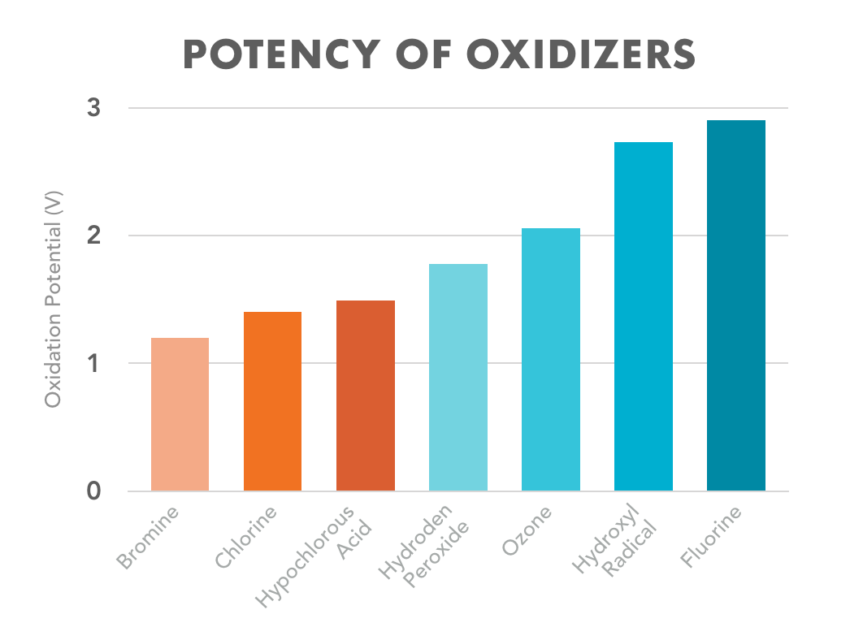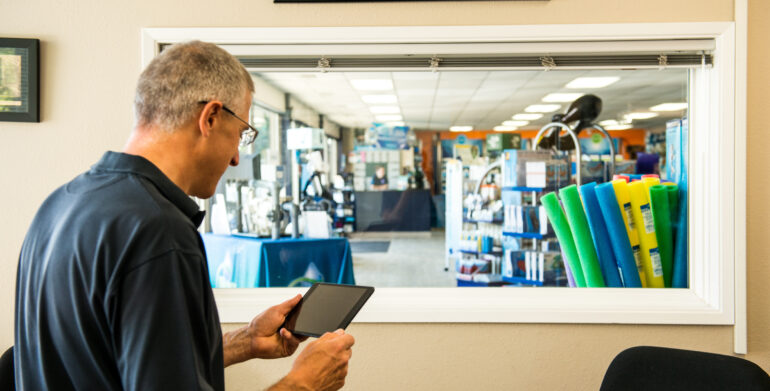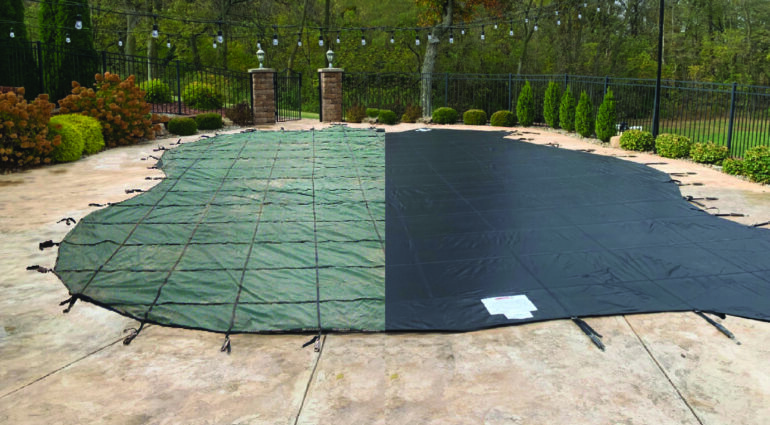AOP Hydroxyl Radicals: A Sea Change for Aquatic Facility Operations
Why hydroxyl radicals are the future of commercial pool water treatment
By Geoff McKenzie, Clear Comfort
Many water care professionals are switching from chlorine alternative disinfection systems such as UV, ozone and saltwater systems to the advanced oxidation process, or AOP sanitation, because of its oxidation power, ability to lower chemical demand and disinfection byproducts, simple maintenance and lower costs. However, many water care professionals are unfamiliar with how AOP hydroxyl sanitation works and what it can achieve. Water care professionals have long struggled with the complexity and costs of many chlorine alternatives. AOP hydroxyl radicals may present the solution.
What is AOP sanitation?
AOP sanitation uses hydroxyl radicals to treat pool and spa water and destroy unwanted organic and inorganic contaminants. As the name alludes to, it is an advanced method to oxidize materials found in pools, spas, waterparks and more, making the water clean, clear and sanitary.
In recent years, AOP sanitation has become increasingly popular for residential and commercial pool and spa treatment (see Figure 1) because it provides powerful sanitation without harmful byproducts or residues. AOP systems even reduce or eliminate disinfection byproducts such as chloramines, which can be detrimental to swimmers’ health6. In addition, AOP doesn’t have some of the limitations or downsides that pool owners and operators experience with other sanitation systems, such as corrosion to pool surfaces.
While UV systems can degrade chlorine in the pool, making it less effective, AOP systems allow lower amounts of chlorine to work more efficiently because they can reduce the organic load without degrading the chlorine. Some AOP systems also operate at a fraction of the electrical consumption compared to many alternatives, making them more economically and environmentally efficient.
What are hydroxyl radicals?
Hydroxyl radicals are highly reactive and oxidative molecules found throughout the Earth’s atmosphere that destroy pollutants and impurities by breaking them down into simpler molecules and decomposing them1. They attack organic pollutants through four basic pathways: radical addition, hydrogen abstraction, electron transfer and radical combination.

Hydroxyls are formed through a process: Oxygen molecules (O2) are broken down into excited atomic oxygen (O1) which react with water molecules (H2O) to form hydroxyl radicals (OH-). Hydroxyls are among the most potent oxidizing agents on the planet that are safe for water treatment. The oxidation potential of the hydroxyl radical (OH-) with available hydrogen (H+) ions far surpasses that of chlorine or molecular ozone [see Figure 1].
In water treatment, the hydroxyls immediately oxidize and break down both organic and inorganic contaminants, including chlorine-resistant Cryptosporidium parvum5. Once they have reacted to the contaminants in the water, they dissipate without leaving any harmful chemicals or residuals behind.
In pools and spas, ‘work’ of advanced oxidation entirely takes place in the plumbing and not in the pool or spa itself. Hydroxyls are highly reactive and last for only a fraction of a second in the plumbing, which means they are never exposed to vulnerable surfaces like tile, grout, coping, decking and mechanical equipment. The addition of hydroxyl AOP sanitation to aquatics facilities allows lower concentrations of corrosive chemicals to be used and preserves surfaces and equipment.
Which pool sanitation systems make hydroxyls?
In pool and spa sanitation, there are three common ways to produce hydroxyls: ozone systems, ozone-UV combination AOP systems and hydroxyl-based (or direct injection method) systems. While all three methods result in the formation of hydroxyls, each one works differently and has varying levels of ‘radical-creation’ efficiency.
Ozone Pool Systems
Ozone systems primarily leverage the oxidative value of O3 to disinfect water. Indirectly, ozone produces hydroxyls in smaller amounts during the stabilization or decay process. This process forms hydroxyls, although perhaps not as efficiently as other AOP methods. In pool and spa treatment, only a small amount of ozone actually ends up forming hydroxyl radicals because they do not all break down into excited atomic oxygen (O1).To overcome the inefficiencies of O2 to O3 conversion, effective ozone systems utilize oxygen concentrators, desiccant air dryers, mixing vessels, degas vessels and ozone destruct chambers. While effective, these systems have proven to be complex and difficult to maintain for the mass-market.
Ozone-UV Combination AOP Pool Systems
In an effort to boost hydroxyl creation, recent systems blend UV and ozone. Ozone-UV AOP systems work by injecting ozone gas in front of a UV system that treats the ozone in the water and encourages hydroxyl formation. Certain wavelengths of UV light break down the ozone molecules, creating atomic oxygen, which then reacts to the water and forms hydroxyl radicals. Ozone-UV combination systems use two separate systems, which increases the complexity with only a partial increase of effectiveness of hydroxyl formation.
Both the UV and ozone systems must be maintained in regular intervals to assure their peak performance. Usually this entails disassembly and reassembly of both systems. Water care professionals have found this to be a time consuming and laborious process. In addition to the complexity of a standalone ozone system as mentioned above, a second system is now being added, which further increases the potential points of failure.
The biggest inhibitor to date for Ozone-UV AOP systems in aquatics has been the inability to scale to larger water bodies. The majority of systems available can only treat up to 50 gallons per minute or less. While newer systems are being designed and launched, their limits appear to only treat up to 500 GPM.
Hydroxyl-based AOP Pool Systems
In recent years, hydroxyl-based AOP systems have come to market and shown strong results. The hydroxyl-based AOP works by directly injecting excited atomic oxygen (O1) into the flow of water. Direct injection simplifies installation while fast-acting hydroxyl reactions do not require complex support infrastructure like the systems previously mentioned. In order to create these unique direct-injection systems, ambient air is exposed to a combination of proprietary UV wavelengths and an opposing magnetic field. The advantage of these systems is their efficiency of power consumption and effectiveness of oxygen conversion.
By producing a steady stream of oxygen radicals in ambient air, direct-injection systems require no degas, no oxygen concentrators, no desiccant air dryers or other complex systems. Hydroxyl-based systems operate off a simple cartridge exchange that takes less than a half-hour per year of total maintenance. These newer technology systems have been shown to scale from spas to waterparks.
When O1 is directly injected into water it creates high concentrations of hydroxyl radicals. The effectiveness of these systems is evidenced in that they have been shown to reduce the chlorine consumed by 30 to 50% while maintaining similar residual levels of chlorine. The hydroxyls are directly replacing the oxidation workload that chlorine was performing previously. Figure 2 shows the chemical savings when direct hydroxyl systems are added to a pool over a nine-month study period.
The AOP Revolution
AOP systems are revolutionizing water treatment for the aquatics industry by bringing accessible, affordable and easy to maintain systems to the water care ecosystem. As water care professionals look to improve their operations, these proven technologies will provide relief from higher chemical costs, pump room complexity and long maintenance hours. More importantly, patrons and facility owners will benefit from better air and water quality and improved facility life. The significant improvements over existing methods that AOP technology offers are enough to represent a complete shift in the way water care professionals approach chlorine alternative sanitation methods.





